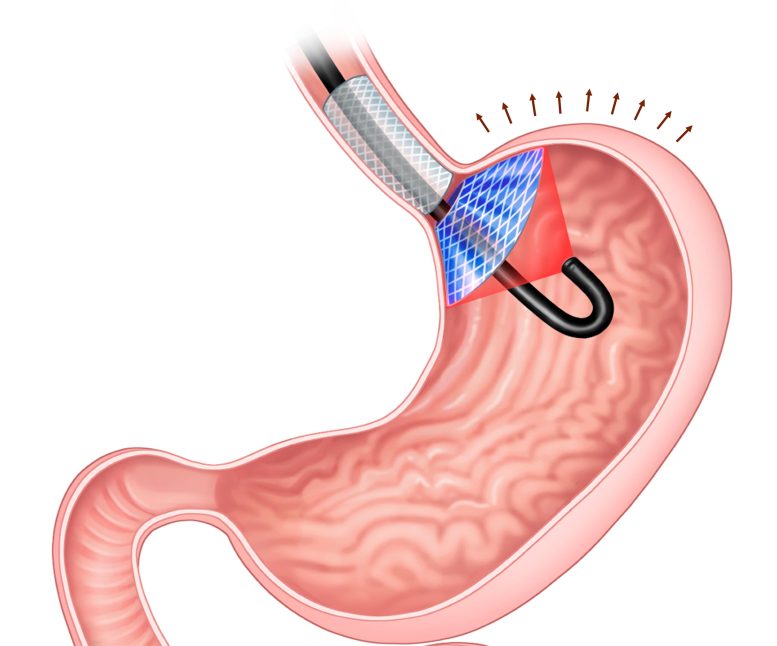
Dans cette illustration, un implant (bleu et gris) crée une sensation de satiété en appuyant sur l’estomac et, lorsqu’il est activé par un laser (noir), tue les cellules qui produisent l’hormone de la faim. Crédit : Adapté de ACS Applied Materials & ; Interfaces 2022, DOI : 10.1021/acsami.2c00532
Lorsque le régime alimentaire et l’exercice physique ne suffisent pas, la chirurgie de perte de poids peut être un traitement efficace de l’obésité. Mais les personnes qui ne veulent pas de chirurgie ont d’autres options, notamment l’insertion d’un ballon coupe-faim ou d’un autre implant dans l’estomac. Aujourd’hui, des chercheurs rapportent dans ACS Applied Materials & ; Interfaces (en anglais) qu’ils ont amélioré cette procédure chez des animaux de laboratoire en recouvrant un implant d’un colorant activé par laser qui tue les cellules produisant la ghréline, l'”hormone de la faim”.
Les implants peuvent être insérés dans l’estomac par la bouche après une anesthésie locale. En 2019, Hwoon-Yong Jung, Jung-Hoon Park et leurs collègues ont conçu un nouveau type d’implant. Le “dispositif intragastrique d’induction de la satiété” (DSI) se compose d’un stent – qui se loge dans la partie inférieure de l’œsophage – attaché à un disque qui repose dans l’ouverture de l’estomac. Le disque est percé d’un trou au centre pour laisser passer les aliments. Des tests effectués sur des porcs ont montré que l’ISD diminuait la prise alimentaire et la prise de poids en renforçant la sensation de satiété et en réduisant les niveaux de ghréline, qui est produite par les cellules situées près du sommet de l’estomac. Mais le dispositif a entraîné des complications, notamment acid reflux and migration into the stomach. In their latest project, Jung, Park, Kun Na, and colleagues wanted to find out if they could suppress ghrelin even more by coating the ISD’s disk with a compound that, with a shot of laser light, could kill some of the ghrelin-producing cells. The implant could then be removed to avoid the side effects associated with the initial design.
In this preliminary study, the team coated ISDs with methylene blue — an FDA-approved drug — and then placed them in the stomachs of young pigs. When exposed to laser light, the coating released singlet oxygen, an energized form of oxygen that killed nearby ghrelin-producing cells in the pigs’ stomachs and then rapidly disappeared. After one week, the treatment reduced ghrelin levels and body weight gain by half compared with an untreated pig, though these differences declined in the following weeks unless the light treatment was repeated. With further development, the simple procedure could become a new type of minimally invasive treatment to help obese patients lose weight, the researchers say.
Reference: “Photodynamic methylene blue-embedded intragastric satiety-inducing device to treat obesity” 6 April 2022, ACS Applied Materials & Interfaces.
DOI: 10.1021/acsami.2c00532
The authors acknowledge support from the Korea Medical Device Development Fund grant funded by the Korean government (Project number: KMDF_PR_20200901_0036).



